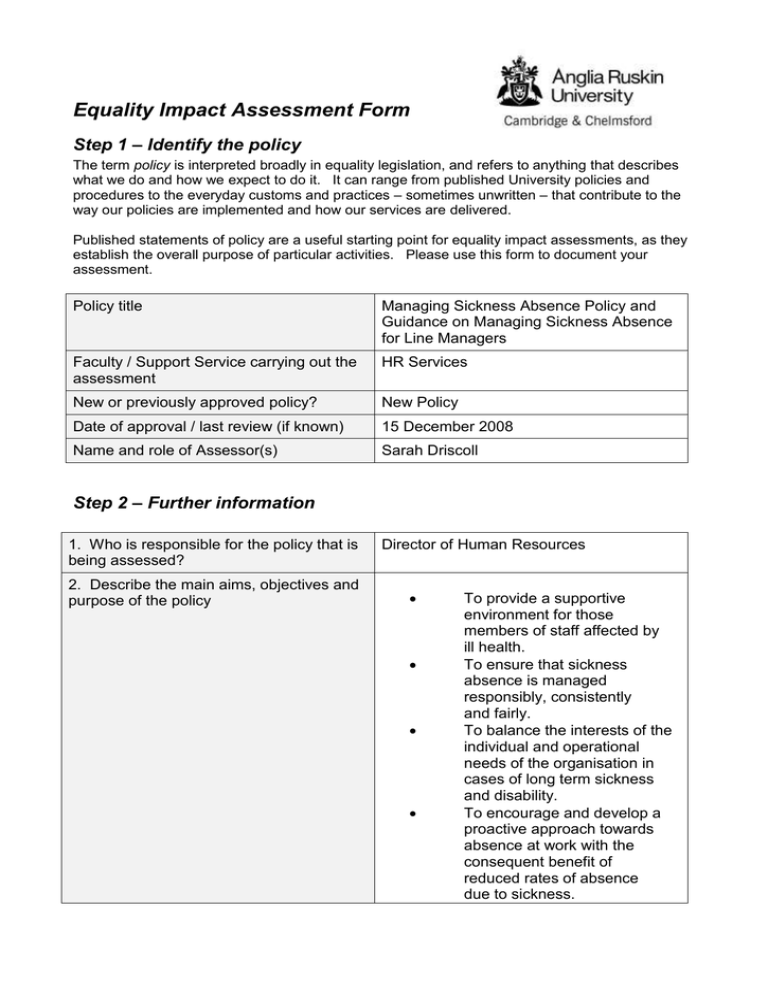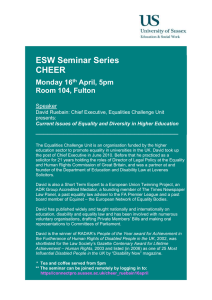Managing Sickness Absence
advertisement

Equality Impact Assessment Form Step 1 – Identify the policy The term policy is interpreted broadly in equality legislation, and refers to anything that describes what we do and how we expect to do it. It can range from published University policies and procedures to the everyday customs and practices – sometimes unwritten – that contribute to the way our policies are implemented and how our services are delivered. Published statements of policy are a useful starting point for equality impact assessments, as they establish the overall purpose of particular activities. Please use this form to document your assessment. Policy title Managing Sickness Absence Policy and Guidance on Managing Sickness Absence for Line Managers Faculty / Support Service carrying out the assessment HR Services New or previously approved policy? New Policy Date of approval / last review (if known) 15 December 2008 Name and role of Assessor(s) Sarah Driscoll Step 2 – Further information 1. Who is responsible for the policy that is being assessed? 2. Describe the main aims, objectives and purpose of the policy Director of Human Resources To provide a supportive environment for those members of staff affected by ill health. To ensure that sickness absence is managed responsibly, consistently and fairly. To balance the interests of the individual and operational needs of the organisation in cases of long term sickness and disability. To encourage and develop a proactive approach towards absence at work with the consequent benefit of reduced rates of absence due to sickness. 3. Are there associated objectives of the policy? If so, please explain. Examples include statutory requirements, sector initiatives, etc. This policy provides the framework for managers to address sickness absence in a way that is consistent and reasonable but reflects that each member of staff’s situation will be different. 4. Who is expected to benefit from this policy? This policy applies to all University employees including those on secondment and sabbatical. 5. Who was consulted on this policy? CMT and trade unions 6. How has the policy been explained to those who would be directly or indirectly affected by it? Publication on HR Online, discussed at Faculty/Support Service management team meetings, article in the staff bulletin. 7. What outcome(s) are meant to be achieved from this policy? Introduction of new processes such as return to work discussions, absence review meetings and use of trigger levels. Reduction in the average number of days off due to absence. Fair and equitable management of long term ill health cases. 8. What factor(s) could contribute to the outcome(s)? Managers’ understanding of and correct implementation of procedures. Strong relationship with Occupational Health Provider. Monitoring of the outcomes of the Sickness Absence Policy 9. What factor(s) could detract from the outcome(s)? Managers’ failure to follow the procedures correctly. Step 3 – Assess the impact on different groups of people 10. In the table below, please tick whether the policy affects particular groups of people – the Equality Target Groups below -- in different ways, compared to other groups. Here are some examples: Positive impact: a policy or practice where the impact on a particular group of people is more positive than for other groups, e.g., accessible website design. It can also include legally permitted positive action initiatives designed to remedy workforce imbalance, such as job interview guarantee schemes for disabled people. Negative impact: a policy or practice where the impact on a particular group of people is more negative than for other groups (e.g., where the choice of venue for a staff social occasion precludes members of a particular faith or belief group from participating). Neutral impact: a policy or practice with neither a positive nor a negative impact on any group or groups of people, compared to others. Equality Target Group Positive impact Negative impact Neutral impact Reasons / comments Men X This policy applies equally to all staff, regardless of gender, race, disability, sexual orientation, religion or age. Women X As above People from black and minority ethnic communities X As above Disabled people X As above. For those employees who develop a disability whilst in employment all reasonable steps will be taken to retain the individual in an appropriate role. Gay, Lesbian and Bisexual People X This policy applies equally to all staff, regardless of gender, race, disability, sexual orientation, religion or age. Transgender people X As above Older people (50+) X As above Younger people (17 – 25) X As above Faith or belief groups X As above Step 4 – Promoting equality 11. Please give a brief description of how this policy promotes equality. It provides a clear framework for managers and staff through which short term and long term absence issues can be addressed fairly and equitably. 12. If there is no evidence that the policy promotes equality, what changes, if any, could be made to achieve this? n/a 13. If there is a negative impact on any equality target groups, can this impact be legally and objectively justified? (If no, then a full Equality Impact Assessment should be completed* ). n/a Step 5 – Recommendation 14. Is a full Equality Impact Assessment required? Signature of Assessor(s): Sarah Driscoll 2008 No x Yes Date15 December Authorised by: (Dean of Faculty, Director of Support Service) Approved for publication by: (Member of the Equality & Diversity Group) * Recommended reading: Conducting Impact Assessments for Equal Opportunities in Higher Education. September 2007, HEFCE and Equality Challenge Unit. This publication is available online in .pdf and text format at: http://www.ecu.ac.uk/publications/ Equality Impact Assessment Flowchart Identify the policy, practice or procedure In its design or implementation, does it intentionally or unwittingly discriminate against particular groups of people, e.g., men, women, disabled people, people from different racial groups and religions, age groups, and sexual orientations? How do you know? Who or what information did you consult? YES Can you legally justify the discrimination on objective grounds? NO UNSURE Ask those most affected, and consult relevant staff or student data. NO How do you know? Who or what information did you consult? Good! There is no need to change this policy at present, though remember to keep it under review. YES You will need to change this policy, practice or procedure. When doing so, you will need to ensure that any amendments made do not result in unjustified discrimination towards other groups. You will then need to repeat the Policy Impact Assessment process. You may need to explain your justification further. A full Policy Impact Assessment may also be required. Recommended reading: Conducting Impact Assessments for Equal Opportunities in Higher Education. September 2007, HEFCE and Equality Challenge Unit. This publication is available online in .pdf and text format at: http://www.ecu.ac.uk/publications/




